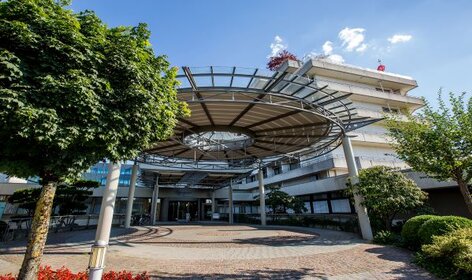Abdominal aortic screening: against the time bomb in the abdomen
Cardiovascular surgery(11.03.2025) Many men are carrying a ticking time bomb. Their abdominal aorta is dangerously dilated and can rupture at any time. Then there is an acute danger to life, says an expert.
As life expectancy increases, so does the number of people who develop problems with their aorta. Doctors refer to the most common and most dangerous complication as an abdominal aortic aneurysm. The main vessel in the abdomen expands considerably until it threatens to rupture. When this happens, a lot of blood flows into the abdominal cavity within seconds and those affected often die before they reach hospital. "Aneurysms are usually discovered by chance because they hardly cause any symptoms at first," says Prof. Dr. Martin Czerny, Medical Director of the Department of Cardiovascular Surgery at the University Heart Center Freiburg - Bad Krozingen at the Freiburg University Medical Center.

A wire mesh, which is advanced via the inguinal vein to the site of the artery, can prevent a life-threatening rupture of the abdominal aorta. University Medical Center Freiburg
Ten-minute ultrasound examination can save lives
Since 2018, health insurance companies have been paying for a preventive examination for men aged 65 and over. This is because four to eight percent of all men of this age have a dangerous vascular dilatation. During the examination, the doctor uses an ultrasound device to measure the diameter of the abdominal aorta. If this is less than two and a half centimetres, the findings are considered normal. If the aorta is more than three centimetres thick, the patient must be checked by ultrasound every six months. If it is five centimetres or more, doctors speak of an aneurysm that requires treatment. Screening can be carried out in any practice using an ultrasound machine.
Those affected almost never have any symptoms - until it is almost too late
Those affected usually have no symptoms. "That's why it's so important that all men take advantage of the screening," says Czerny. Only when the aorta is about to rupture do those affected notice pain, usually in the back area. Immediate surgery is then necessary. "At the Clinic for Cardiovascular Surgery, which has one of the longest-standing and largest aortic centers in Germany, more than 700 operations are performed on the entire aortic organ every year."
Four out of five patients receive minimally invasive treatment
"The abdominal aorta can be treated by open surgery or minimally invasive surgery. Which type of surgery is chosen always depends on the patient and their condition," says Czerny. In a minimally invasive procedure, a wire mesh, known as a stent graft, is advanced via the groin vessels under X-ray control to the site of the bulge and expanded there. This is also known as an endovascular procedure. Around 80 percent of all patients with abdominal aortic aneurysms are treated minimally invasively at the University Heart Center. In acute and particularly complex cases, an open surgical procedure is performed.
After the procedure is before aftercare: aortic passport helps
"We firmly believe that aftercare is just as important as preoperative preparation and treatment," says Czerny. This is why all patients who have been treated for an aortic aneurysm in the clinic are regularly examined in the aortic outpatient clinic after the procedure and receive an aortic passport. This contains information about the disease, interventions that have taken place, an individual sketch of the aorta, the date of the next check-up and the contact details of the contact persons at the clinic. "This is how we ensure that the time bomb in the abdomen doesn't start ticking again unnoticed," says Czerny.
More interesting articles
Medical Center - University of Freiburg
Central InformationPhone: 0761 270-0
info@uniklinik-freiburg.de
Corporate Communications
Breisacher Straße 15379110 Freiburg
Phone: 0761 270-84830
kommunikation@uniklinik-freiburg.de



